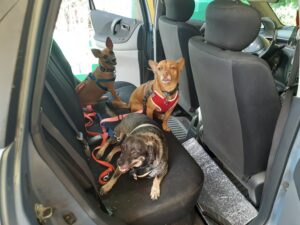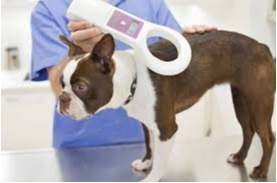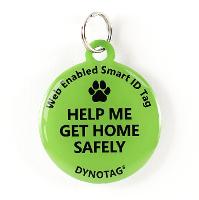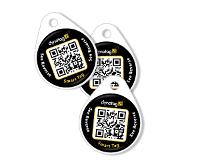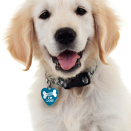My dog got lost, how do I find it?
Avoid losing or getting your dog stolen
How to find your dog if it gets lost or stolen
The Story of My Pets
Through my life I have adopted over forty (40) dogs. Dogs of all sizes and colors. I was six (6) years old when I had my first dog, a small dog that I called “Llanero”. When I was seven (7) years old my parents moved out of town. I had to leave my dog with my grandparents. Four (4) years later we returned to our hometown. My grandparents informed me that my dog had died.
A few years after returning to my hometown, we had our first family adopted dogs. On those years there were no consciousness of taking pets to a veterinary. In reality, there were none in town. No prescribed medicines. The basics were to have them at the yard, give them food, and sometimes a bath. If they got sick home remedies and treatments were given.
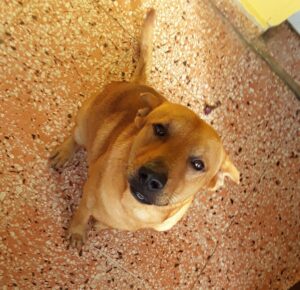
The nearest animal health professional was the local agronomist from the Agriculture Extension Service Office. These were the town’s plant and animal physicians. They worked helping the local farmers and ranchers. Almost all neighbors had pets. Usually, stray dogs and cats. People didn’t worry about having their pets stolen. Few worried if they got lost. Dogs could be lose around the house or tied with ropes or chains.
Although I had my dogs lose en even with the porch door open, none got lost or escaped. No dog tags were used. Microchips or trackers were unknown. No technology available.

When those dogs died, they were buried around the families’ farms. Práctically, we had pet cemeteries in our properties. As the years went by we awaken conscience on the correct ways to care for our pets. Especially, when one of our most loved dog died. We realized that if we had taken better care of him, Pirulo, he could have lived many more happy years. A few weeks later we adopted a chihuahua, Sr Topito. Immediately we kept him inside the house, we didn’t do that with the dogs before him.

We have special attention to Sr. Topito, even taking him to the veterinary. Taking pets to verterinaries had become a common behavior. And ther were a few available. We neuterede him, gave him his monthly worm and heart pills. Tick and flea treatment, too. Dog shampoo baths. And dog walks. A collar with dog tag identification. Has another dog tag with QR code so that if he gets lost someone with a cell phone can access our address and phone number.
When he is left around outside the house, the porch is closed. He is never left alone. We frequently play with him. He is super intelligent, fast learner. Before we didn’t play with our pets, we had them and that’s it. Like having any other object.

After Topito we adopted Evaristo, another chihuahua, but mixed. The same process as with Sr. Topito. This one came with a series of health conditions that we treated rapidly with a veterinary. He has his dogtag and QR dogtag. With this dog we have to be more careful because he is a very slow learner. Then came Antonella, a female chihuahua that we went to another town to pickup. She barks 24/7. This one has in addition to the dogtags a microship. Went through the same process as the other dogs. She was maltreated by a boy with mental conditions. She was afraid of men. We had to work on that, now she is confident of all people, men and women. After Antonella came Bella. This girl came from a litter of five dogs. Three of them were killed by cars. We rescued her and another dog was rescued by a neighbor. Same process as the other dogs. She is very active, athletic. Great energy.
There was a dog that would visit several houses in the neighborhood. Carmelo is very friendly. He had had a few accidents during his visitings. We were going to adopt him, to get him out of the street, but a neighbor was very interested in him. They adopted him and is the king in that family. Lastly, came Pistacho, and old age dog. He is a wisedog, very intelligent and gental. Loves to be caress. Went through the same process as the other dogs.
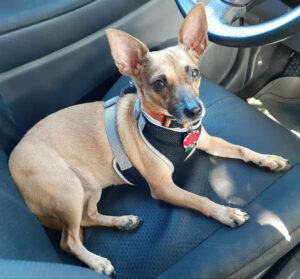
En una ocasión, Evaristo, huyéndole a otro perro, en la pista de caminar, salió corriendo y no lo encontrábamos. Diez personas tuvimos buscándolo por toda el área. Dos horas después lo encontramos escondido en la marquesina de una casa.
Ahí comprendimos que aunque cuidamos bien a nuestras mascotas y tenían las chapitas y microchips, necesitábamos algo más seguro y confiable por si se perdían. Investigamos y nos dimos cuenta que el próximo paso era comprarles un GPS (rastreador para perros). Con esta tecnología se puede localizar a la mascota en cualquier sitio donde esté. No hay que volverse locos búscandola, adivinando dónde pueda estar. Ya los tenemos preparados con los rastreadores.

Dogtags, QR code dogtags, cell tackers, microchips, and gps trackers are important to protect our pets. The investment in money is nothing comparing from the peace of mind that one has. A pet, dog or cat or other, can get lost or stolen in any moment. It doesn’t matter how careful one is protecting them. One second distraction, and your pet is gone, disappears.
Our pets, dogs or cats, are part of our family, they even serve as therapy. They enlighten our lives. Just knowning that they are well fed, healthy, happy, protected, make our lives happy.

Why we have to protect our pets!
Every year more than ten millions (yes, 10,000,000+) of dogs are lost in the USA. In other parts of the world similar numbers are true, too.
The majority of these dogs are never found. Los for ever, never returning to their homes and families.
This creates a series of emotional disturbances in the families that lose their dogs, their so much loved furring friends. Pain, suferring, anguish and despair. Even more of they are service, company and/or emotional support dogs. Even of the loved pet is recovered, the few times that this happens, while they are lost, the anguish is despairing. Minutes seem hours, and hours seem days. The faster the pet is found the less anguish.
Why pets get lost?
Pets get lost ofr a number of reasons. May of them preventables. Pets get lost when they flee from home or when they distracted get too far from home and can’t find their way back. This could be because of playing, or chasing something or somebody, most of the time, another animal. Dogs are very curious and investigators. Anything can catch their attention y distract them. When they realize their surroundings they are very far from home and family.
This is a frequent scenario when they are taken for a walk, to family and friends houses, and other places that are far from home, and their away from their daily surroundings like parks, parkings, green areas, beaches, etc.
Loud sounds make these hearing sensitive beings go on a run. Loud sounds hurt their ears and they run away. Thunder, lighting, electric storms, gunshots, explosions, fireworks, etc. Maltreatment will alse make them flee from houses.
Some say that by the smell dogs can return home, but many times this is not true.
Why dogs are stolen
There are many reasons for dogs to be stoled, too. Two basic reasons. The main one is for money. The other one is because someone likes your dog and he takes it as soon as he can.
Stolen dogs for money is the most common cause. The more expensive the dog, the most probability it has to be stolen. Depending on what the dog is wanted for and the demand for it will be the price. That is the temptation for it to be stolen. Breed, size, color, abilities, fur, and appearance could be incentives to steal a dog.
Another reason to steal or to get rid of a dog is that it is not wanted in the neighborhood and a resident steals it to sell it, give it away or just throw the dog away. And that way the dog doesn’t bother the community. There could be other reasons, too.
Prevention or how to avoid that your dog gets lost
Eliminating or reducing situations that can provoke that a dog can get lost or that it is stolen is almost a daily task. It is said that it is better to prevent than have to remedy. There could be the possibility of not having a remedy if no prevention or the due diligence is taken.
There are many ways to prevent that a dog doesn’t get lost or that it doesn’t run away from home. Avoiding that the dog escapes or gets lost. First, if the dog is in a yard, have the yard with a good fence. Preferably that the fence be a smooth wall. That the fence is not with horizontal bars or with spiderweb type wires, like cyclone fence. This is to avoid that the dog uses the bars or spiderweb fence as a ladder and climb over the fence and get to the outside. Even if you don’t believe it, they are intelligent and they do that. Good climbers. I have had them, acrobatic dogs, that climb fences as they were ladder steps or jump over them. I had a dog that could jump easily a five feet fence Happens often.
The fence can be with vertical tubes or bars if they are close enough to avoid the dog going between them or getting stuck between them. A vertical tubing can’t be used as a ladder. It has to be high so that it can’t be jumped. The fence must have a good foundation below in the ground, because they, too, dig under the fence to build a tunnel or passage to get to the other side, to the free community.
If the dog is inside the house it is more easily controlled. You should have caution with doors that lead to the outside. Dogs take advantage of any opportunity to go through the doors or any other openning to the outside. Take care of always having those doors closed. When going out beware of that the dog doesn’t slip out between your legs. Better is to have baby gates so that they can’t step outside. You can train your dog not go on the streets alone.
It is very risky to have a dog outside without a good fence. Even if you can train your dog not to cross certain limits. Even with that, some event can or special situation can call his attention or scare him y make him cross those limits. Running after another animal or scaping.
The dog can be tied to a collar or chain. This requires surveillance. He can get entangled in the chain, another dog can come and attack him and he not be able to defend himself or escape. Another option is placing him in a ample cage with a dwelling space inside to receive protection from weather inclement, rain or sun.
When you your dog for a walk, always have him with collar and chain. You should never have him loose in public areas. He can disappear in any moment. Another situation is female dogs in heat. A male dog will seek the female, and a female dog will attract male dogs. Dogs can detect a female in heat from far away.
How to prevent that your dog is stolen
There are ways on how to reduce the risks of your dog being stolen. In addition to those that apply so that your dog doesn’t get lost. What is indispensable is to have him under surveillance at all times. Because when you less expect it, your dog will be stolen. Among these are having a security camera where the dog is. Better if they detect movement. That way every time someone gets near where the dog is, the cameras will give the warning.
Never leave your dog alone. Not in the dog park, not in green areas, not at the entrance of stores, not in your vehicle, not when visiting someone.
How to recover your lost or stolen dog
It doesn’t matter how many measures of cautions and cares you take, always some event could occur where you lose sight of your four leg child, your furry love, and lose him. Be it that it escaped or was stolen. What do you do?
First you should have taken the active cautions so that you can recover your dog in the event that something like that happens.
What do you do to recover your pet?
You have the advantage that at this age there exist some technological advances that can help you recover your loved furry friend. There exists a series of devices and systems that help to recover lost dogs and even stolen ones. The cases that most occur are lost dogs. So that you have good probabilities of recovering your Fido, if you apply those systems now. That four legged friend returns to you.
Opciones para recuperar a tu perro perdido:
There exist groups that are dedicated to look for and/or promote and publicize lost or stolen pets in social medias. There are microchips implants in the dogs skin, dogtags that have the owners phone number, QR dogtags where someone with a cell phone can scan the QR code and access the dog’s owner’s phone number and other pet information. And, there are the cell phone dog trackers that indicate where the dog is. These have the limitation that they only function for short distances, even a few feets away from the cell phone. If the dog goes too far this tracker won’t track or detect the dog. Then which is the best dog tracking device?
Satellite dog trackers (GPS)
The most efficient way to know where your pet or dog could be is with a satellite or GPS tracker. Your pet will have it on his collar. It doesn’t weight much and it is easy to put on the collar. This device sends a signal to a satellite, and this satellite will send a signal to a service center that can be access by the pet’s owner on a web page or cell phone. The pet’s location is located through Google Maps.
The dog’s activities can be monitered, health condition, heart rhythm and others. They use batteries, therefore, they have to be charged. Depending on its use charge can last several days. You can track the dog in other states and even in other countries. It is the best that exists to locate stolen or lost pets.
Don’t risk losing your most loved pet or dog, forever. Get this device today!
This is the most sold dog and cat GPS tracker at Amazon.
Click the image now!
Am 3
= ===============================================================
Get all the products and accessories that you need and want for your pet:
The pet warehouse with more than 40 mil (40,000+) products for your pets:
